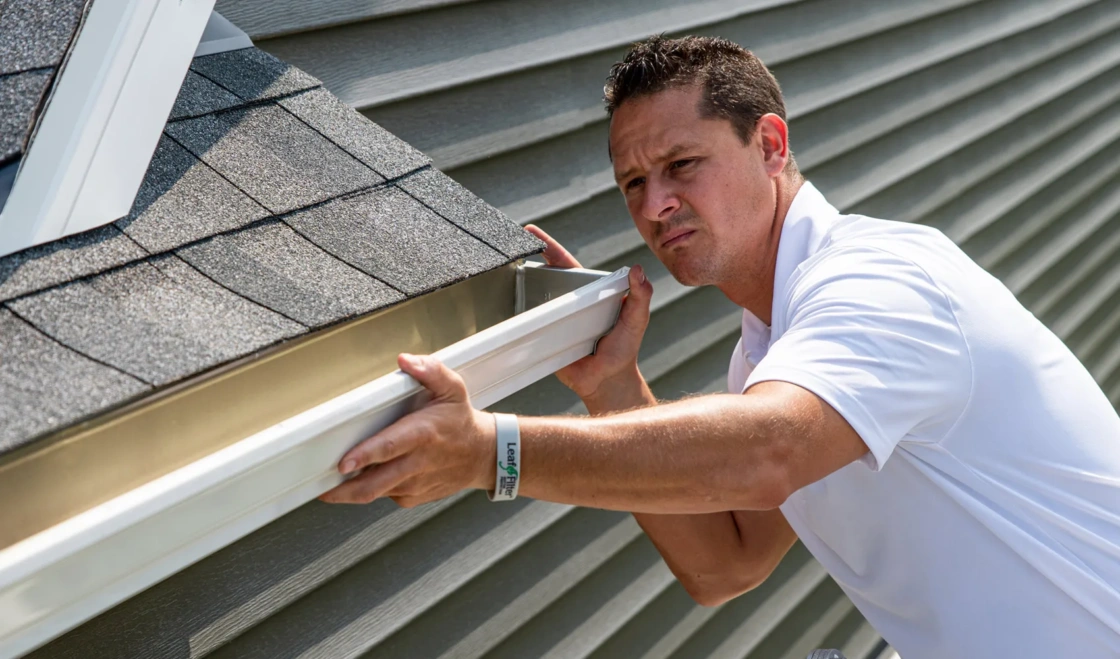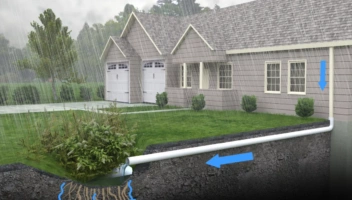How to Install Gutter Guards in 4 Basic Steps

Gutter guards—also known as leaf guards—are gutter protection devices designed to keep your gutters clear and functional by allowing water to flow freely while preventing debris from clogging your gutters. They are placed over or inside your gutters to block leaves, sticks, animal nests, and other debris that can build up over time.
If not cleaned out, these types of debris can block the flow of water. Over time, this can lead to water damage, basement flooding, and even foundation cracking.
Though it’s wise to regularly clean your gutters to avoid these problems, gutter guards can help reduce the need for regular maintenance. Nobody likes having to climb a ladder and scoop out wet leaves and gunk.
In this article, we’ll discuss:
- How to Install Gutter Guards Yourself
- Mistakes to Avoid When Installing Gutters
- DIY Gutter Guard Install vs Hiring a Pro
- Final Thoughts
- Frequently Asked Questions
How to Install Gutter Guards Yourself
The gutter guards found at Home Depot, Lowe’s, and other home repair stores are often meant for DIY installation. Exactly how you install them will depend on the type of gutter guard you purchase, but the basic installation steps typically include the following.
1. Evaluating and Measuring Your Gutters
Begin by measuring the length and width of your gutters. It’s crucial to identify their shape and style to ensure you select the appropriate type of gutter guard. Note that some guards may require professional installation, which could affect your choice.
Attention homeowners! 🏡 Did you know that LeafFilter offers FREE estimates for your gutter protection needs? Say goodbye to clogs and hello to peace of mind with LeafFilter!✅ To learn more and get started today, visit https://t.co/6tWbQ0wMvX #ClogFree #FreeEstimate #LeafFilter pic.twitter.com/9JOuBzi7Mp
— LeafFilter Gutter Protection (@LeafFilter) July 18, 2023
2. Choosing the Appropriate Gutter Guard
Selecting the right gutter guards is important in ensuring the longevity and effectiveness of your gutter system. Here are key factors to consider when making your decision:
Cost
The cost of gutter guards can vary significantly based on the material and design. While budget-friendly options may be appealing, they often offer less durability and protection. Investing in higher-quality guards can save money in the long run.
Ease of Installation
Different types of gutter guards have varying installation requirements. Some, like brush or foam guards, are easy to install and suitable for DIY projects. Others, such as micro-mesh or reverse-curve guards, might require professional installation due to their complexity.
Location
Your geographic location plays a significant role in determining the best type of gutter guard. Areas with heavy rainfall, snow, or high winds may benefit from more robust and secure options like micro-mesh guards. Conversely, regions with mild climates might find that simpler solutions like screen guards suffice.
Performance
The effectiveness of gutter guards in keeping debris out while allowing water to flow freely is critical. Each type of gutter guard has its strengths and weaknesses:
- Brush Gutter Guards: These are effective for larger debris but may require frequent cleaning as smaller particles can accumulate.
- Foam Guards: These fit inside the gutter and block most debris but may degrade over time and need replacement.
- Screen Gutter Guards: These sit on top of the gutter and are good at keeping out larger leaves and twigs but might let smaller debris through.
- Micro-Mesh Guards: Known for their fine mesh, these guards provide excellent protection against small debris like pine needles and shingle grit, though they typically require professional installation.
- Reverse Curve Gutter Guards: These gutter covers direct water into the gutter while deflecting leaves and larger debris. However, they can sometimes struggle with finer particles.
3. Preparing for Installation
The installation process varies depending on the type of gutter guard selected, but you can follow these general preparation steps to ensure a smooth installation:
- Gather Tools and Materials: Lay out all necessary materials and tools, including a ladder, gloves, tool belt, and screwdriver. For two-story homes, an extension ladder is essential. Ensure the ladder is placed on a flat surface and have someone act as a spotter for safety.
- Clean Out Gutters: Remove any leaves, twigs, or other debris from the gutters. Use a hose to flush out the gutters and check the water flow.
- Repair Any Leaks: Inspect your gutters for any damage or holes and repair them before installing the gutter guards.
- Choose the Right Time: Avoid installing gutter guards during adverse weather conditions like rain, snow, or strong winds. Select a calm and dry day for installation.
- Follow Manufacturer Instructions: Each type of gutter guard has specific installation instructions. Carefully read and follow these guidelines to ensure proper installation.
Remember to dispose of all packaging and unused materials after installation properly.
4. Step-by-Step Guide to Gutter Guard Installation
With everything prepared, you are ready to begin the installation. Here are detailed steps for installing various types of gutter guards:
Brush or Foam Gutter Guards:
- Placement: Insert the brush or foam guards directly into your gutters.
- Trimming: Trim the guards to match the length of your gutters using appropriate cutting tools.
Plastic or Metal Gutter Guards:
- Installation: Slide one side of the guard under the first row of roof shingles.
- Securing: Attach the other side to the gutter using snaps, clips, tape, brackets, or screws, as specified in the manufacturer’s instructions.
- Trimming: Trim the guards as needed to fit your gutter system.
Micro-Mesh Gutter Guards:
- Installation: Place the micro-mesh guards over your existing gutters.
- Attachment: Secure them to the outer edge of the gutter.
- Refer to Manufacturer’s Website: For detailed steps, consult the manufacturer’s website for specific instructions.
Following these steps, you can effectively install the best gutter guards to protect your home from water damage and debris accumulation.
Mistakes to Avoid When Installing Gutter Guards
- Not Cleaning Gutters Before Installation: Debris left inside the gutters can obstruct water flow and defeat the guards’ purpose, leading to potential water damage and increased maintenance needs.
- Incorrect Measurements: Accurate measurements are essential for a successful installation. Inaccurate measurements can result in gaps or ill-fitting guards that fail to protect your gutters effectively.
- Choosing Cheap Quality Material: While opting for low-quality materials may save money initially, they can lead to more frequent replacements and repairs. High-quality gutter guards are more durable and provide better protection, ultimately offering better value for your investment.
- Neglecting Safety Measures: Failing to use proper equipment or not having a spotter can result in accidents or injuries. Always follow safety guidelines, use appropriate tools, and ensure stable ladder placement to prevent falls.
DIY Gutter Guard Install vs Hiring a Pro
When deciding between DIY gutter guard installation or hiring professional installers, there are several critical factors to consider. Here’s a breakdown to help you make an informed decision:
DIY Gutter Guard Installation
Pros:
- Cost Savings: Installing gutter guards yourself can save money upfront since you won’t have to pay for professional labor.
- Flexibility: You can work on your own schedule and pace to manage your time as needed.
Cons:
- Safety Risks: Climbing ladders and working at heights pose significant safety risks. According to the American Ladder Institute, 500,000 people are treated for ladder-related injuries annually. The risk of injury is a serious consideration.
- Equipment Needs: DIY installation requires specific tools such as a stand-alone ladder, bucket with S-hook, circular saw, and safety glasses. Ensuring you have all the necessary equipment is essential.
- Skill and Expertise: Successfully installing gutter guards requires a good understanding of home repair skills. Mistakes can lead to improper installation, potential damage to gutters or the roof, and ineffective gutter protection.
Professional Gutter Guard Installation
Pros:
- Safety: Professionals are trained and equipped to handle installations safely, significantly reducing the risk of accidents or injuries.
- Efficiency and Quality: With their expertise, professionals can ensure that the gutter guards are installed correctly and efficiently. Placing them at the correct pitch provides optimal performance.
- Warranty and Support: Many professional services offer warranties on their work, giving you peace of mind and protection against future issues.
Cons:
- Cost: Hiring a professional can be more expensive than doing it yourself, as you will need to pay for labor and potentially higher-quality materials.
While DIY installation can be cost-effective and rewarding, hiring a professional installer ensures safety, quality, and peace of mind. Assess your comfort level with the required skills and risks, and consider consulting a professional for the safest and most reliable results.
Final Thoughts
While installing gutter guards yourself is possible, it’s best to consult the experienced professionals at LeafFilter for professional installation of our proven, patented technology. Our stainless steel micro mesh gutter guards allow only water to enter your gutters, reducing maintenance and cleaning demands while protecting your home from the potential dangers and costly repairs that could result from poor gutter maintenance.
Frequently Asked Questions
Can I install gutter guards myself?
You can install gutter guards yourself if you have the right tools and follow safety precautions. DIY installation of certain types like brush or foam guards is relatively straightforward. However, more complex systems like micro-mesh guards may require professional assistance to ensure proper placement and effectiveness.
How much does it cost to install gutter guards?
The cost to install gutter guards varies based on the type and quality of the material. On average, homeowners can expect to spend between $4 to $12 per linear foot for materials, with professional installation adding to the overall expense. High-end options and professional services can increase costs.
What do roofers say about gutter guards?
Roofers generally recommend gutter guards as they help prevent debris buildup and reduce the need for frequent cleaning. However, they emphasize choosing high-quality guards and ensuring proper installation to avoid issues like water damage or gutter misalignment.
What are the disadvantages of gutter guards?
While gutter guards minimize maintenance by keeping debris out, they are not entirely maintenance-free. Some disadvantages include the initial cost, the need for occasional cleaning, and potential installation challenges. In some cases, smaller debris may still enter, requiring periodic inspection and cleaning.
What is the expected lifespan of gutter guards after installation?
The expected lifespan of gutter guards varies by material and quality. High-quality stainless steel or aluminum guards can last 20 years or more, while less durable options like plastic or foam may need replacement every few years. Proper installation and regular maintenance can extend their lifespan.
Check out all of LeafFilter’s gutter guard locations for professional installation.


